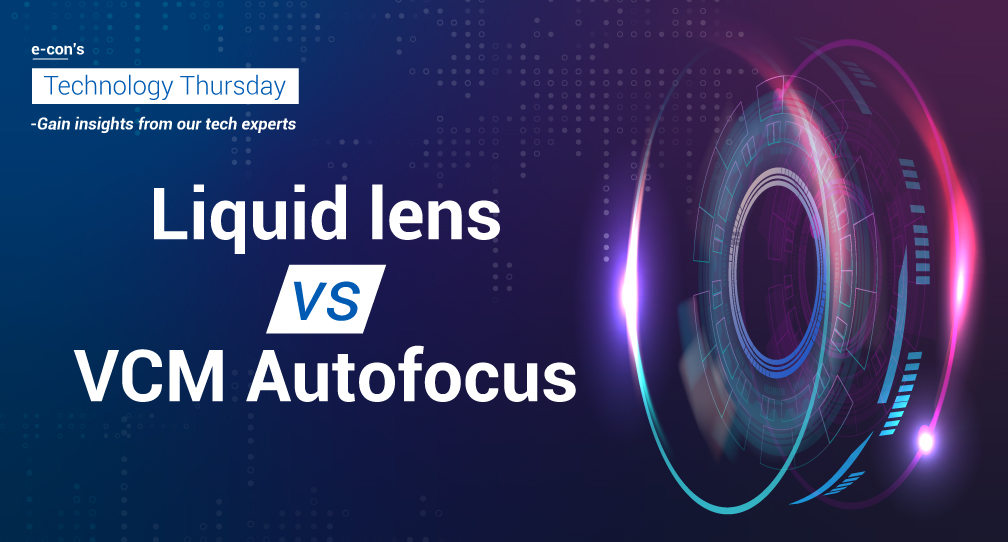This blog post was originally published at e-con Systems’ website. It is reprinted here with the permission of e-con Systems.
Autofocus is one of the key features required for many embedded vision applications. An autofocus camera module is typically used when the distance to the target object keeps varying during image capture. This requires the camera to quickly lock onto the target object to make sure that it is in focus. Some of the applications that might require an autofocus camera include industrial handhelds, document scanners & cameras, dental cameras etc.
Designing an autofocus camera involves using an autofocus lens which comes in two variants – liquid lens autofocus, and Voice Coil Motor (VCM) autofocus.
But how do you pick the right lens out of the two? What are the factors you need to consider while choosing one for your application or product? Where is each of them used? In this article, we aim to answer these questions in detail.
Factors to consider while choosing an autofocus lens
There are predominantly 9 criteria based on which you make a choice between a liquid lens and VCM lens. They are:
- Amount of heat dissipated
- Precision and lifetime
- Operating temperature range
- Time taken to focus
- Power consumption
- Size and weight
- Type of lens mount
- Cost
- Supply chain and availability
Let us look at each of these in detail now.
Amount of heat dissipated
In a VCM autofocus lens, autofocus is achieved by means of the mechanical movement of the lens. A change in position of the lens with respect to the image sensor is required every time the camera needs to change its focal length. This frequent movement of the lens causes friction, and hence results in more heat dissipation.
Whereas in a liquid lens, autofocus is achieved by the movement of the liquid inside the lens in accordance with the electric field applied on it. This would mean that the lens does not have to change its position or move mechanically to alter its focal length. Owing to this, there is much less heat dissipation in a liquid lens in comparison with a VCM lens.
So, if your product or application demands controlled heat, liquid lens is a better choice to go with.
Precision and lifetime
Constant movement in a VCM lens results in wear and tear of its mechanical parts. This in turn results in shorter lifetime. Also, this wear and tear could over a time lead to lesser precision. Hence in cases where a high life span and precision are required, an autofocus camera with liquid lens is recommended.
Operating temperature range
Due to the fact that liquid autofocus lenses dissipate less heat, they tend to operate reliably in wider temperature ranges as opposed to VCM lenses. Many embedded vision use cases – especially those which require cameras to operate in industrial environments – demand a high temperature range, in which case a liquid lens is preferred.
Time taken to focus
A VCM autofocus lens requires the motor to move to change its focus. This takes more time. However, a liquid lens can rapidly change its focus in as short a time as a few milliseconds. In applications where the time delay between capturing two successive images of objects at varying distances, a liquid lens wins the race.
Power consumption
A VCM powered autofocus lens is more power hungry than a liquid lens due to regular movement of the motor. Hence, if you have restrictions in terms of the power your autofocus camera can draw, using a liquid lens is one of the ways to optimize power efficiency.
Size and weight
A VCM lens has a few mechanical parts. Also, it needs to have the room within for the lens to move back and forth to adjust the focal length. These make a VCM lens bulkier than a liquid lens. A VCM lens is also much heavier.
Type of lens mount
A VCM motor can power only tiny cameras such as the ones you see in cell phones. If you are trying to achieve autofocus with an M8 or M12 lens, then liquid lens is the way to go.
Cost
All the factors we discussed earlier indicate that liquid lens is much better than a VCM lens when it comes to features and functionalities. However, these advantages do come with cost implications. VCM technology is highly cost effective compared to liquid lens autofocus. When it comes to thousands in volume, VCM beats liquid lens hands down in terms of pricing.
Supply chain and availability
The supply chain ecosystem for VCM lenses is wider, and hence availability is much better. So, you are likely to have a better choice when it comes to picking a supplier in case of a VCM autofocus lens.
Conclusion
So, here is how we would conclude. Your choice of autofocus lens primarily depends on your application or product. If your application is such that you do not have a predefined set of focus distances, then you need to go with a liquid lens. An OCR reader or camera is an example for such an application. At the same time, if you have a leeway in terms of the precision, lifespan, power consumption, lens mount etc. you could pretty much pick a VCM autofocus lens over a liquid lens. So, have a detailed look at all the factors discussed above before you make a call.
Got any questions or queries around the topic? Please drop a note to [email protected].
Prabu Kumar
Chief Technology Officer and Head of Camera Products, e-con Systems,


